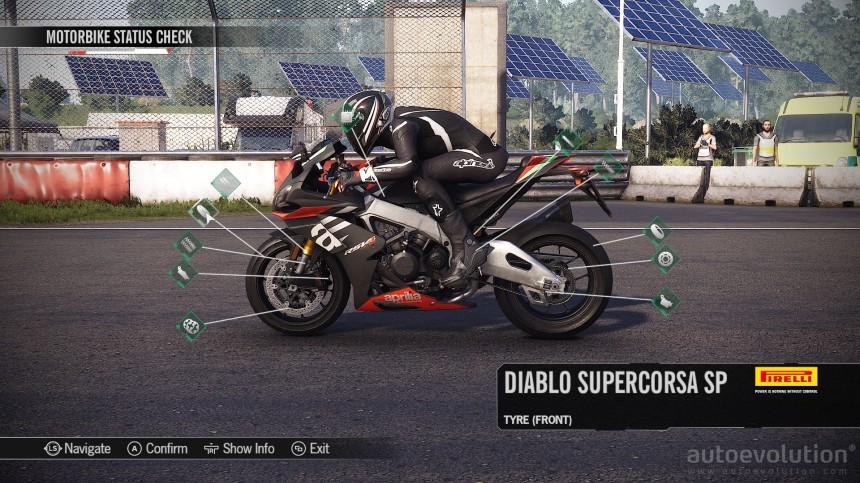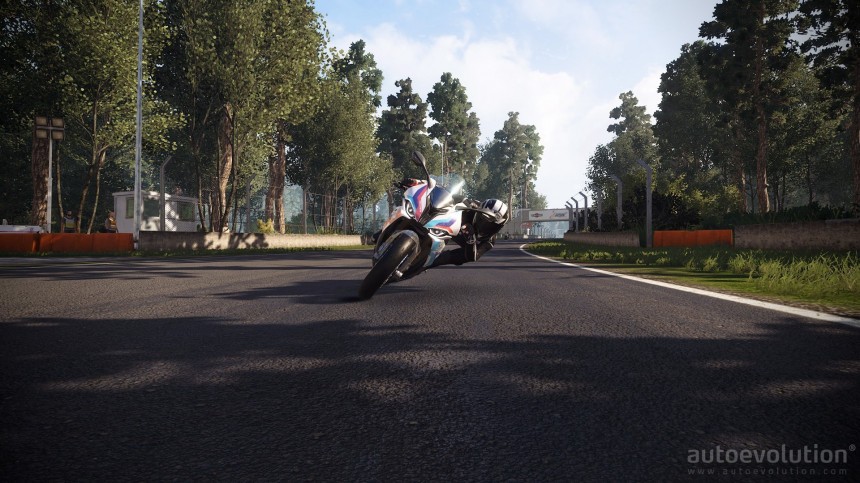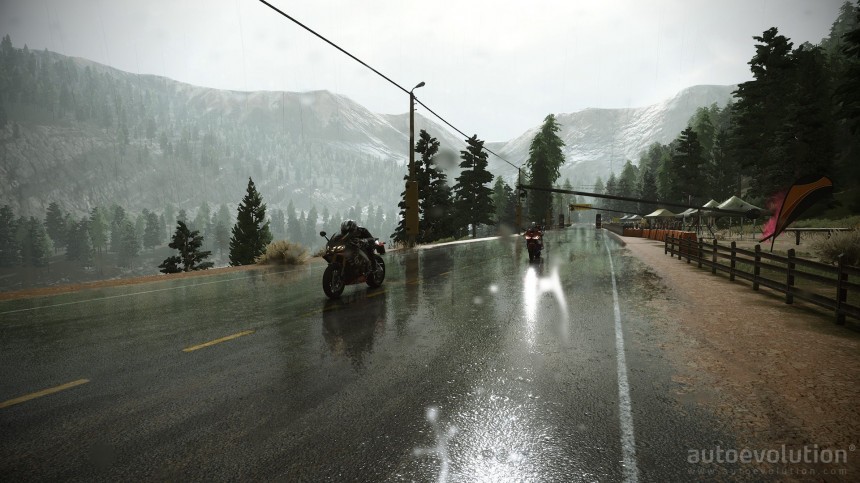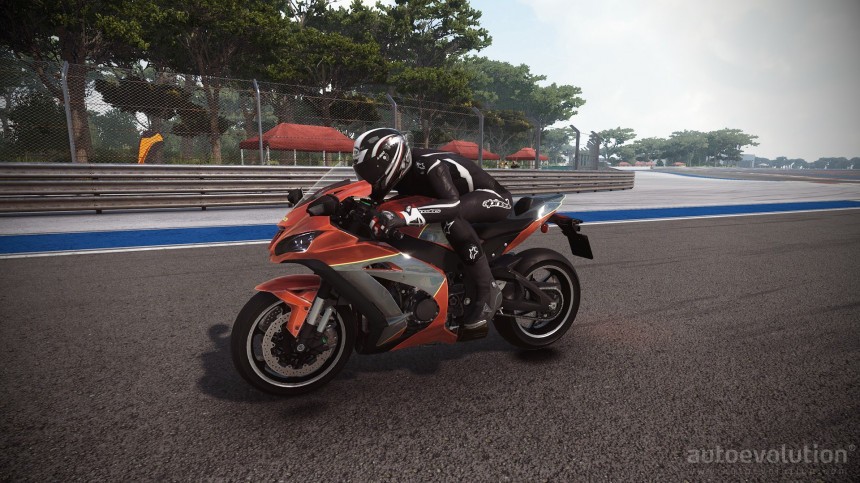There are many things I like about Raceward Studio’s RiMS Racing, but the one thing that will stay with me after hours of frustration for not getting the controls right, is how ridiculously accurate the bikes in the game have been recreated. It’s not just what they look like, but also how they sound and, arguably, the way they behave on the track.
Despite the fact that it prides itself on a level of accuracy that matches realistic motorbike physics, RiMS Racing’s audience isn’t limited to hardcore fans. The game has three levels of difficulty that are tailored for just about every type of player, so if you’re a rider in real life, you might want to try playing RiMS Racing on the hardest difficultly for a painstakingly realistic race experience.
My first date with RiMS Racing was brutal, not because I was intimidated by the infinite number of customization options, but rather due to my inability to keep my bike on the track for more than a few minutes. I jumped into RiMS Racing thinking that going from four wheels vehicles to just two will be a breeze, so I wanted to see what a realistic bike simulator feels like.
I played a few hours on the hardest difficulty trying to set adjust the controls so the bike would respond to my commands faster and with more accuracy, but nothing really meaningful changed for me. What did change was how my bike would perform on the track when I mingled with some of the components in the shop.
RiMS Racing lets you ride just eight bikes from European and Japanese manufacturers – Ducati Panigale V4 R, MV Agusta F4 RC, Aprilia RSV4, BMW M 1000 RR, Suzuki GSX-R1000R, Honda CBR1000RR, Kawasaki Ninja ZX-10RR, and Yamaha YZF-R1, on 14 tracks. They truly have been recreated to match their real-life counterparts to the last screw, at least that’s what I believe from what I’ve seen in the game.
I know that just eight bikes and 14 tracks for a $50 game are not a lot, but the folks at Raceward Studio focused on quality rather than quantity. I’m pretty sure that more bikes will be added in the form of DLC later on, but let’s talk a bit about what makes RiMS Racing stand out.
Apart from the realistic bike riding part, RiMS Racing lets you customize your motorbike using a massive catalog of over 500 official spare parts from the biggest names in the industry. For hardcore racers, this is probably a dream come true, but I don’t think many will appreciate what Raceward Studio has done with the game.
You see, when you play RiMS Racing on the hardest difficulty, many of these components will definitely change your bike’s behavior. However, you’ll need to spend time testing various setups, and with more than 500 pieces at your disposal from the get-go, many will probably give up before trying to adjust their bikes for certain tracks and weather conditions.
Don’t get me wrong, it’s very easy to switch to a tire that’s more suitable for rainy days when you know you’re going to race on a wet track, but it’s an entirely different thing to fine-tune your bike with discs, suspensions and other spare parts that will affect your bike’s behavior in certain scenarios.
However, all these amazing options that allow you to mingle with your bike’s parts becomes redundant when you play RiMS Racing on lower difficulties. Yes, your bike’s components are prone to tear and wear, so you’ll have to switch them for new ones from the shop, but that’s probably the only reason you’ll want to do that.
There isn’t too much strategy involved when RiMS Racing isn’t played as a fully realistic riding simulator: you just hop on your bike, win the race, and move on to the next event.
RiMS Racing’s Career mode offers a glimpse at how it feels to be part of racing team. You have your own headquarters fully equipped with an R&D area, a Workshop where you can dismantle your bike to pieces or replace spare parts, a Calendar that gives you access to 70 events, and that’s just about it.
In Career mode, you go through the 70 events that you can see in the Calendar with the bike you choose. The other seven bikes will unlock as you progress, and the money you gain winning events can be used to buy spare parts or upgrade your team’s skills. Many of the skills that you can unlock using team points awarded after winning some of the events are just for flavor or not that useful unless you play on the hardest difficulty.
For example, your R&D department can tell you the weather conditions on a track before the race. This is a very useful piece of information if you want to adjust your bike’s setup. You can even see the bike setup of your opponents before the race if you unlock a certain team skill.
Moving on to the physics and handling of the motorbikes, I admit that I had a great time riding my bike in RiMS Racing, but not on the greatest difficulty. Bike racing requires a lot of finesse and, as your pilot is constantly shifting positions, it’s important that the controls work flawlessly, something that RiMS Racing didn’t really achieve. I had to fiddle with controls.
First off, bikes have two independent brakes – front and rear, and while you can bind them both to the same button, that’s inadvisable unless you’re not playing on lower difficulties. The rear brake especially is essential in correctly adjusting your bike’s position before a chicane. Equally important in your success on the track is how your rider leans their shoulders or shuffle their body on the bike.
If you want an authentic motorbike experience, RiMS Racing will definitely quench your thirst, but the game is quite difficult if you’re looking for that 100% realistic experience.
My main gripes with the game are the weird (and disappointing) structure of the Career mode and the finicky controls, especially on the higher levels of difficulty where perfect accuracy is needed.
I believe RiMS Racing will offer a great experience to hardcore bike racing fans, but newcomers to the genre will definitely find it enjoyable as well. The best thing about Raceward Studio’s game is that it has a little bit of something for everyone, yet I can’t help but wonder if it doesn’t offer too little for the price.
RiMS Racing walks a fine line between frustration and pleasure, but if you can find the equilibrium, chances are that you’ll find it very entertaining.
Rating: 85/100
My first date with RiMS Racing was brutal, not because I was intimidated by the infinite number of customization options, but rather due to my inability to keep my bike on the track for more than a few minutes. I jumped into RiMS Racing thinking that going from four wheels vehicles to just two will be a breeze, so I wanted to see what a realistic bike simulator feels like.
I played a few hours on the hardest difficulty trying to set adjust the controls so the bike would respond to my commands faster and with more accuracy, but nothing really meaningful changed for me. What did change was how my bike would perform on the track when I mingled with some of the components in the shop.
RiMS Racing lets you ride just eight bikes from European and Japanese manufacturers – Ducati Panigale V4 R, MV Agusta F4 RC, Aprilia RSV4, BMW M 1000 RR, Suzuki GSX-R1000R, Honda CBR1000RR, Kawasaki Ninja ZX-10RR, and Yamaha YZF-R1, on 14 tracks. They truly have been recreated to match their real-life counterparts to the last screw, at least that’s what I believe from what I’ve seen in the game.
Apart from the realistic bike riding part, RiMS Racing lets you customize your motorbike using a massive catalog of over 500 official spare parts from the biggest names in the industry. For hardcore racers, this is probably a dream come true, but I don’t think many will appreciate what Raceward Studio has done with the game.
You see, when you play RiMS Racing on the hardest difficulty, many of these components will definitely change your bike’s behavior. However, you’ll need to spend time testing various setups, and with more than 500 pieces at your disposal from the get-go, many will probably give up before trying to adjust their bikes for certain tracks and weather conditions.
Don’t get me wrong, it’s very easy to switch to a tire that’s more suitable for rainy days when you know you’re going to race on a wet track, but it’s an entirely different thing to fine-tune your bike with discs, suspensions and other spare parts that will affect your bike’s behavior in certain scenarios.
There isn’t too much strategy involved when RiMS Racing isn’t played as a fully realistic riding simulator: you just hop on your bike, win the race, and move on to the next event.
RiMS Racing’s Career mode offers a glimpse at how it feels to be part of racing team. You have your own headquarters fully equipped with an R&D area, a Workshop where you can dismantle your bike to pieces or replace spare parts, a Calendar that gives you access to 70 events, and that’s just about it.
In Career mode, you go through the 70 events that you can see in the Calendar with the bike you choose. The other seven bikes will unlock as you progress, and the money you gain winning events can be used to buy spare parts or upgrade your team’s skills. Many of the skills that you can unlock using team points awarded after winning some of the events are just for flavor or not that useful unless you play on the hardest difficulty.
Moving on to the physics and handling of the motorbikes, I admit that I had a great time riding my bike in RiMS Racing, but not on the greatest difficulty. Bike racing requires a lot of finesse and, as your pilot is constantly shifting positions, it’s important that the controls work flawlessly, something that RiMS Racing didn’t really achieve. I had to fiddle with controls.
First off, bikes have two independent brakes – front and rear, and while you can bind them both to the same button, that’s inadvisable unless you’re not playing on lower difficulties. The rear brake especially is essential in correctly adjusting your bike’s position before a chicane. Equally important in your success on the track is how your rider leans their shoulders or shuffle their body on the bike.
If you want an authentic motorbike experience, RiMS Racing will definitely quench your thirst, but the game is quite difficult if you’re looking for that 100% realistic experience.
Conclusion
Ultimately, RiMS Racing delivers on its promise: a realistic bike racing experience and a mechanics management system never before seen in a game. Whether or not the way they have been implemented will appease the audience is something for each and everyone to decide.My main gripes with the game are the weird (and disappointing) structure of the Career mode and the finicky controls, especially on the higher levels of difficulty where perfect accuracy is needed.
I believe RiMS Racing will offer a great experience to hardcore bike racing fans, but newcomers to the genre will definitely find it enjoyable as well. The best thing about Raceward Studio’s game is that it has a little bit of something for everyone, yet I can’t help but wonder if it doesn’t offer too little for the price.
RiMS Racing walks a fine line between frustration and pleasure, but if you can find the equilibrium, chances are that you’ll find it very entertaining.
Rating: 85/100






































